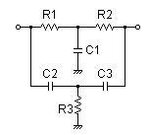lhlblue
Member level 3

below is the schematic of twin-t filter, and the transfer function of it. in actual design, it can also be used for bandpass filter if connected between negative input and output of opamp. now, the twin-t network is a three order system, so, how to get the expression of center frequency f0 and quality factor Q? for two order system, we use 's^2+(2*pi*f0/Q)*s+(2*pi*f0)^2' to calculate f0 and Q, but for the three order system, how to calculate the parameter f0 and Q?
thanks all.


thanks all.




